
The Sienese School of painting flourished in Siena, Italy, between the 13th and 15th centuries. Its most important artists include Duccio, whose work shows Byzantine influence, his pupil Simone Martini, the brothers Pietro and Ambrogio Lorenzetti and Domenico and Taddeo di Bartolo, Sassetta, and Matteo di Giovanni.
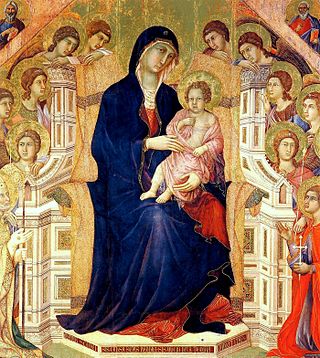
Duccio di Buoninsegna, commonly known as just Duccio, was an Italian painter active in Siena, Tuscany, in the late 13th and early 14th century. He was hired throughout his life to complete many important works in government and religious buildings around Italy. Duccio is considered one of the greatest Italian painters of the Middle Ages, and is credited with creating the painting styles of Trecento and the Sienese school. He also contributed significantly to the Sienese Gothic style.

Alphonsus is an ancient impact crater on the Moon that dates from the pre-Nectarian era. It is located on the lunar highlands on the eastern end of Mare Nubium, west of the Imbrian Highlands, and slightly overlaps the crater Ptolemaeus to the north. To the southwest is the smaller Alpetragius. The crater name was approved by the IAU in 1935.
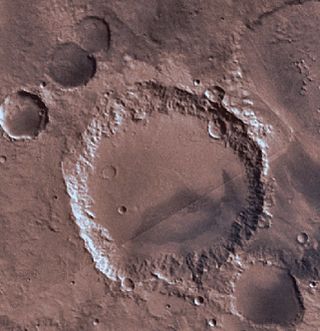
Beer is a crater lying situated within the Margaritifer Sinus quadrangle (MC-19) region of the planet Mars, named in honor of the German astronomer, Wilhelm Beer. It is located at 14.4°S 351.8°E.

Sunset Crater is a cinder cone located north of Flagstaff in the U.S. state of Arizona. The crater is within the Sunset Crater Volcano National Monument.
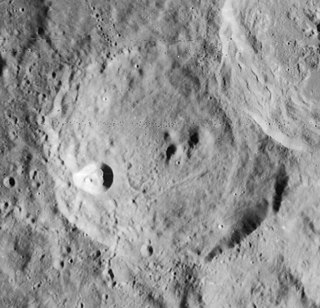
Cyrillus is a lunar impact crater located on the northwest edge of Mare Nectaris. Intruding into the northeast rim is the slightly larger, and younger crater Theophilus. To the south is another prominent crater named Catharina. Together these three craters form a prominent trio in the southeast quadrant of the Moon. To the northwest is Ibn-Rushd. Cyrillus is named after Saint Cyril of Alexandria, a 4th-century Coptic Pope and theologian.

Madonna and Child was painted by one of the most influential artists of the late 13th and early 14th century, Duccio di Buoninsegna. This iconic image of the Madonna and Child, seen throughout the history of western art, holds significant value in terms of stylistic innovations of religious subject matter that would continue to evolve for centuries.

Victoria is an impact crater on Mars located at 2.05°S, 5.50°W in the Meridiani Planum extraterrestrial plain, lying situated within the Margaritifer Sinus quadrangle (MC-19) region of the planet Mars. This crater was first visited by the Mars Exploration Rover Opportunity. It is roughly 800 metres (2,600 ft) wide, nearly eight times the size of the crater Endurance, visited by Opportunity from sols 951 to 1630. It is informally named after Victoria – one of the five Spanish ships of Ferdinand Magellan and the first ship to circumnavigate the globe – and formally named after Victoria, Seychelles. Along the edges of the crater are many outcrops within recessed alcoves and promontories, named for bays and capes that Magellan discovered.

Giuliano Gemma was an Italian actor. He is best known internationally for his work in Spaghetti Westerns, particularly for his performances as the title character in Duccio Tessari's A Pistol for Ringo (1965), Captain Montgomery Brown/'Ringo' in Tessari's The Return of Ringo (1965), the title character in Michele Lupo's Arizona Colt (1966), Scott Mary in Tonino Valerii's Day of Anger (1967) and Michael "California" Random in Lupo's California (1977).

The Tempio Malatestiano is the unfinished cathedral church of Rimini, Italy. Officially named for St. Francis, it takes the popular name from Sigismondo Pandolfo Malatesta, who commissioned its reconstruction by the famous Renaissance theorist and architect Leon Battista Alberti around 1450.

The Maestà, or Maestà of Duccio, is an altarpiece composed of many individual paintings commissioned by the city of Siena in 1308 from the artist Duccio di Buoninsegna and is his most famous work. The front panels make up a large enthroned Madonna and Child with saints and angels, and a predella of the Childhood of Christ with prophets. The reverse has the rest of a combined cycle of the Life of the Virgin and the Life of Christ in a total of forty-three small scenes; several panels are now dispersed or lost. The base of the panel has an inscription that reads : "Holy Mother of God, be thou the cause of peace for Siena and life to Duccio because he painted thee thus." Though it took a generation for its effect to be truly felt, Duccio's Maestà set Italian painting on a course leading away from the hieratic representations of Byzantine art towards more direct presentations of reality.

The Victoria quadrangle is a region on Mercury from 0 to 90° longitude and 20 to 70 ° latitude. It is designated the "H-2" quadrangle, and is also known as Aurora after a large albedo feature.

Duccio Tessari was an Italian film director, screenwriter and actor, considered one of the fathers of Spaghetti Westerns.
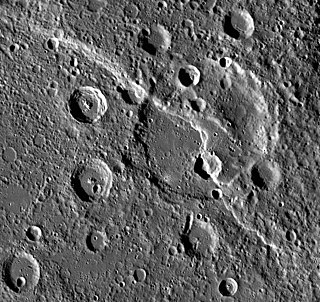
Discovery Rupes is an escarpment on Mercury, approximately 267 kilometers (166 mi) long, located at latitude 58.52 N and longitude 53.25 W. It was formed by a thrust fault, thought to have occurred due to the shrinkage of the planet's core as it cooled over time. The scarp cuts through Duccio crater.
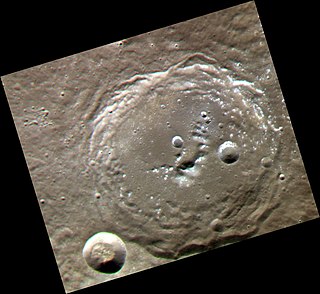
Boznańska is a crater on Mercury. Its name was adopted by the International Astronomical Union (IAU) on September 25, 2015. Boznańska is named for the Polish painter Olga Boznańska.
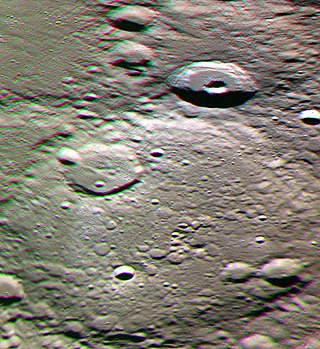
Rubens is a crater on Mercury. Its name was adopted by the International Astronomical Union (IAU) in 1979, after Flemish painter Peter Paul Rubens.

Louth is an impact crater on Mars located at 70.19°N 103.24°E in the Mare Boreum quadrangle. Located within Vastitas Borealis, the crater has a diameter of 36.29 kilometres and is named after Louth, a town in Ireland.

















